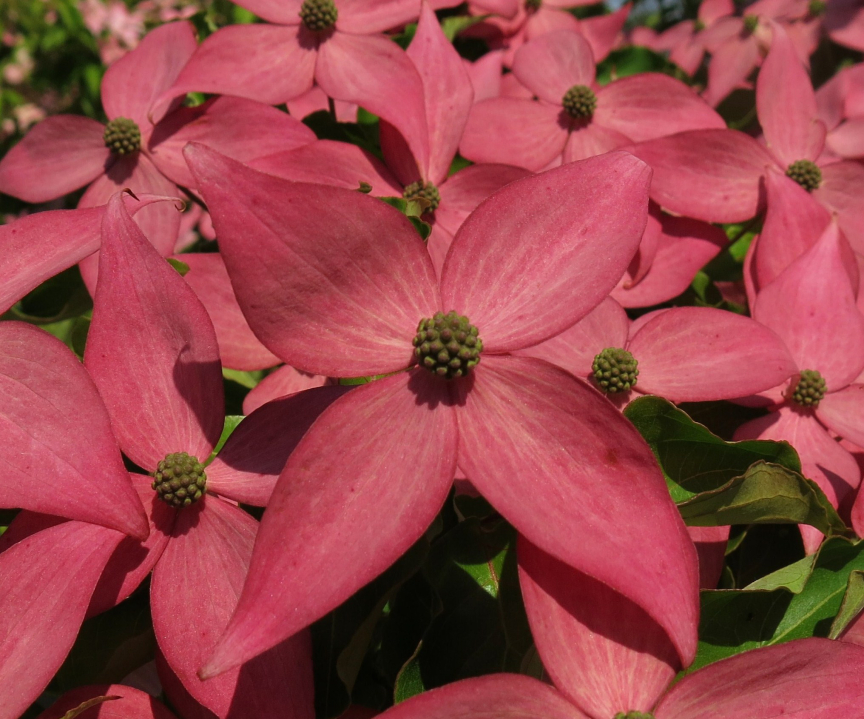Rutgers’ New Pink Dogwood Adds Breakthrough Color to the Landscape
After decades of breeding, researchers released the Scarlet Fire, the first Asian dogwood of its kind with deep pink color

Rutgers researchers have developed a hardy, pink dogwood tree that promises to add vibrant color to the landscape in New Jersey and beyond.
The new dogwood, called Scarlet Fire, is the answer to a riddle that has eluded plant biologists for decades. It achieves the brilliant color associated with the native Cornus florida species that has been plagued by blight in the hardier Cornus kousa – an Asian species that is resistant to most diseases but lacked some of the color that made the native species so attractive.
Sold in limited quantities last spring, the Scarlet Fire dogwood will be widely available for the first time in 2017 through mail order from nurseries.
“I would say almost every yard in New Jersey has a dogwood tree in it,’’ said Tom Molnar, a plant biologist who oversees the ornamental tree breeding program for the Rutgers New Jersey Agricultural Experiment Station.
“These are trees that are supposed to be pretty, but powdery mildew and other diseases make them look ugly most of the year,’’ Molnar said.
Irv Paulus, the general manager of RareFind Nursery in Jackson, one of the first retail-mail order nurseries to sell the Scarlet Fire dogwood, started off with 40 plants available last winter. He sold out in less than a month and then began filling orders off of a waiting list of more than 100 customers. This year he has about 250 in stock for the start of the season.
Paulus said the Scarlet Fire offers something special that has been missing from the landscape.
“Before blight came through and wiped out a lot of dogwoods, pink was very prevalent,’’ Paulus said. “I would walk up the street in my neighborhood and see masses of white and pink in late spring and then one by one they all died.’’
“A 20-foot or 30-foot tree in pink is stunning,’’ Paulus said. “It’s a great tree to have in the landscape, and, of course, here in New Jersey the fact that it was developed at Rutgers makes it more special.’’
Molnar took over the project to develop a pink Asian dogwood tree about a decade ago from retired plant biologist Elwin Orton, who had been working on the breeding program for decades. Orton knew the landscape industry was searching for a tree to replace the native dogwood that was being ravaged by insects and disease.

The Asian dogwood had the hardiness and disease resistance the industry wanted but not the color to set it apart – it bloomed each spring with white or very light pink flowers.
“The desire was to get something as tough as the Asian dogwood with that great pink color,’’ Molnar said.
He tested genetic combinations that built on the previous generations of work of Orton, crossing trees that produced light pink flowers and then grew out thousands of plants until he found the desired brightness.
“I was very lucky, he gave me all these parents to work with through his decades of work and one of the crosses we made gave us this really bright color,’’ Molnar said. “When we first saw it flower we were all blown away. It was a breakthrough color.’’
The Scarlet Fire stands out in the landscape for its timing and shade of pink. The dogwood flowers toward the end of May and early in June, later in the season than most flowering trees. Molnar said he chose the name Scarlet to honor Rutgers 250th anniversary and Fire for the hue of the flower.
“It gives this new splash of color we have never seen before on the landscape,’’ Molnar said. “At its peak it’s close to a fuchsia color. What is most pleasing about it is that from a distance it reflects light and you see this really brilliant splash of pink.’’
The Scarlet Fire has a similar range as the native dogwood, Molnar said. It can grow in USDA plant hardiness zones 5 through 8, as far south as Florida north of New Jersey into Connecticut and as far west as central Pennsylvania and Ohio.
“This is a tougher plant that takes the heat and drought better and is resistant to different diseases,’’ Molnar said. “It’s the first of its kind with such color and we are hoping it becomes very popular when everyone sees it.’’
For media inquiries contact andrea.alexander@ucm.rutgers.edu or 848-932-0556